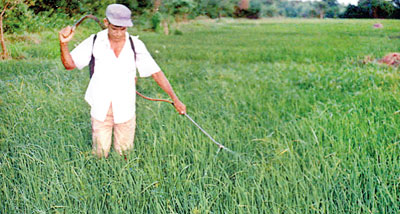Sunday Times 2
Kidney disease: A possibility overlooked
View(s):By Jatal D. Mannapperuma
Kidney disease in the dry zone has become the subject of renewed discussion after the submission of the final report by the World Health Organisation. The key findings of this report identify long-term exposure to arsenic and cadmium as the cause of the disease. It rules out drinking water as the possible source of exposure but points to the food chain as a possibility.

A recent study reported that arsenite uptake through the skin is 29 times higher than arsenate uptake and cautioned that dermal exposure resulting from standing in contaminated water in rice fields may be grossly underestimated.
Elimination of water as a source comes as a surprise to many because high levels of 20-200 ug/L were reported (www.arsenic.lk) in drinking water sources of patients. Drinking water containing high arsenic levels is generally accepted as the source of arsenic in kidney patients in Bangladesh.
Rice, being the staple food in the country, has received due diligence as a possible source in the food chain. Arsenic content in rice has increased from below 100 ug/kg in 2004 to 500 ug/kg in 2011 (www.arsenic.lk). However, unlike water, rice from the dry zone is consumed all over the country but it has not been implicated in kidney disease in the wet zone.
When drinking water and staple rice are not possible sources of arsenic, the search for overlooked possibilities or a missing link has to begin in earnest. Absorption through the skin — as an overlooked possibility — is the route discussed here.
Most of the published past research conclude that the absorption of arsenic through the skin is negligible. However, recent research has begun to contradict this. Arsenic exists in several organic and inorganic forms. The most dominant are the inorganic forms; trivalent arsenite and pentavalent arsenate. The arsenate form gets reduced to arsenite under anoxic conditions found in paddy fields and deep reservoirs.
A recent study reported that arsenite uptake through the skin is 29 times higher than arsenate uptake and cautioned that dermal exposure resulting from standing in contaminated water in rice fields may be grossly underestimated.
Arsenite is more toxic than arsenate and also more soluble. Removing arsenic through reverse osmosis is successful with arsenate but only partially with arsenite. At neutral and acidic pH found in the environment and the human body, arsenate is largely ionised while arsenite is not. This difference is mostly responsible for the difference in behaviour of arsenate and arsenite.
Lesions on the feet and hands are a primary symptom of arsenic poisoning. Once lesions develop on the skin the uptake of arsenic could increase well above the uptake through intact skin and result in a spiraling effect.
This hypothesis of arsenite absorption through the skin as the mode of arsenic uptake by the human body requires further testing and verification. The practice of treating all forms of arsenic as equal has to change to form specific analysis. Protective wear for feet and hands could be introduced and its effect could be studied to expedite the potential remedial strategy.
(Jatal D. Mannapperuma, Ph.D, has worked on advanced water treatment in the United States and presently resides in Kandy. He could be contacted at jatalm@live.com)
Follow @timesonlinelk
comments powered by Disqus

















